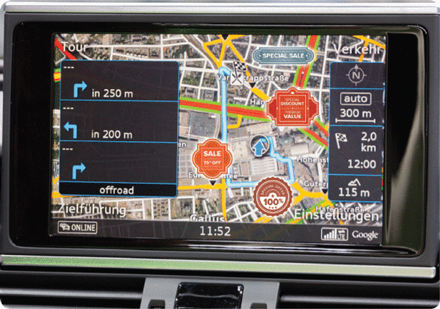|
Advertisement (ad) delivery is expected to play a crucial role in future vehicular networks. In this article, the authors examine how ads can be broadcasted by roadside units (RSUs) as well as vehicles and then displayed to interested users.
The authors describe the ad dissemination process by means
of an optimization model that aims to maximize the number of ads that users
display within the target area and validity period of the ad. They then solve
the optimization problem, obtaining the optimal scheduling strategy that RSUs
and vehicles should adopt for ad broadcasting.
The study highlights the important role that
vehicle-to-vehicle (V2V) communications will have in ad delivery. Also, it
shows how coexisting vehicular and cellular networks can effectively complement
each other, with vehicular networks being a very efficient means for pervasive
ad dissemination.
 Vehicular networking is one the most important enabling
technologies for a massive set of applications related to vehicles, such as traffic
management, transport efficiency, user entertainment, office on-wheels,
commercial and tourist information, mobile shopping, and emergency management
applications. Vehicular networking is one the most important enabling
technologies for a massive set of applications related to vehicles, such as traffic
management, transport efficiency, user entertainment, office on-wheels,
commercial and tourist information, mobile shopping, and emergency management
applications.
From the networking viewpoint, an interesting development in
this context is the integration of infrastructure-to-vehicle (I2V) with V2V
communications. Such an integration can enhance the dissemination of
information from the network infrastructure to the vehicles with the data
collected by the vehicles themselves. The authors envision a highly scalable
mechanism for gathering and disseminating data about traffic conditions,
tourist information, and location-aware ads.
In this article, the authors investigate how ad services can
be effectively supported in vehicular systems. Indeed, mobile advertising
already provides huge revenues, and it is also expected to do so in the
vehicular context. In particular, relying on the successful business model that
has been adopted for websites, Internet blogs, and social networks, we address
the delivery of targeted ads to cars.
Targeted advertising is especially relevant as it is
beneficial to both advertisers and users: advertisers can gain higher revenue
by delivering an ad to users with a strong potential to purchase, and users, in
turn, receive more pertinent and useful information that matches their
interests. Clearly, users' interests may be driven by various factors such as
personality, likes, and dislikes.
Since a vehicular scenario is addressed, this work considers that they are driven also by geographical position and time of the
day. Then, given the users' profiles and current/predicted mobility, ads are identified by which users are likely interested and exploit this
information to select the set of ads that RSUs (e.g., base stations and WiFi
access points) as well as fellow vehicles should broadcast.
Full
article: IEEE Vehicular Technology Magazine, Volume 12, Number 3, September 2017 |